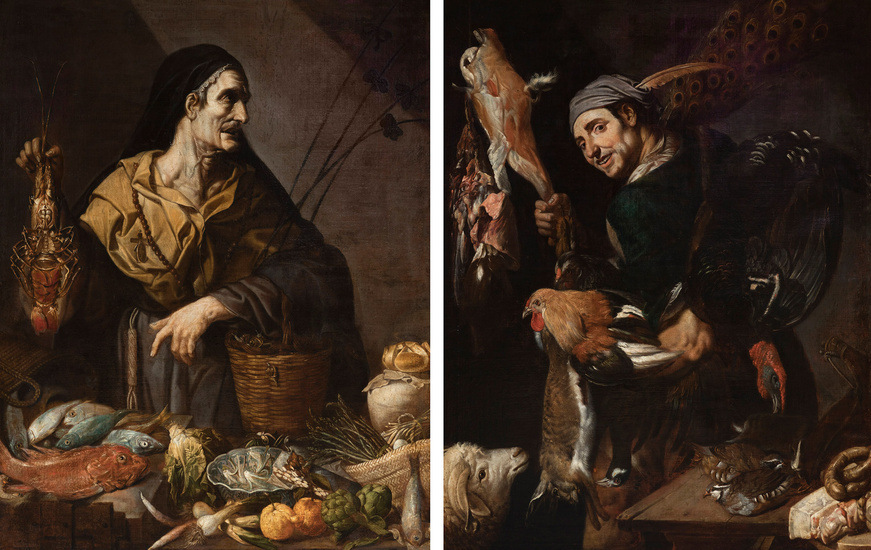Attributed to Adriaen Van Utrecht
Attributed to ADRIAEN VAN UTRECHT (Antwerp, 1599 - 1652),
"Fish seller and butcher".
Oil on canvas. Reetelados.
They present label of the seizure board.
They have frames of the nineteenth century.
Provenance: Duques de la Conquista.
Measurements: 157 x 127 cm (x2); 199 x 168 (frames, x2).
In this pair of oil paintings two of the great genres of the Flemish and Dutch Baroque are combined: genre painting and still life. Thus, the still life is presented as part of a more complex composition, starring a large figure, in both cases, which also takes center stage by holding part of the still life and showing it to the viewer, integrating it into the scene, as if it were a buyer. A clearly baroque scenographic resource. The various foods are arranged in the foreground, in an open, asymmetrical and dynamic composition, typically baroque, while the figure is relegated in space, although its central position in the scene and the monumentality of the forms do not detract from its presence. In both paintings the author shows a great mastery that is demonstrated by the complexity of the detail of the still life, but also the naturalistic look with which the figures are treated indicates the great aesthetic and technical quality of both paintings.
It is this quality that is largely reminiscent of the aesthetics of the artist Adriaen van Utrech, a Flemish painter known primarily for his sumptuous still lifes of banquets, still lifes of game and fruit, fruit garlands, market and kitchen scenes, and depictions of live poultry in pens. His paintings, especially the hunting and game pieces, show the influence of Frans Snyders. The two artists are considered the principal inventors of the genre of pronkstillevens, that is, still lifes that emphasized abundance by depicting a diversity of objects, fruits, flowers, and dead game, often along with live people and animals. Van Utrecht did not favor bright colors as Snyders did, but preferred warm earth tones, especially grayish green, and strong chiaroscuro effects. The latter probably stemmed from his knowledge of Italian painting and, in particular, the works of Caravaggio's followers. Van Utrecht also painted a series of still lifes of flowers. He was a regular collaborator with leading Antwerp painters who had been pupils or assistants of Peter Paul Rubens, such as Jacob Jordaens, David Teniers the Younger, Erasmus Quellinus II, Gerard Seghers, Theodoor Rombouts, Abraham van Diepenbeeck and Thomas Willeboirts Bosschaert.
COMMENTS
They present the label of the seizure board.
View it on
Sale price
Estimate
Time, Location
Auction House
Attributed to ADRIAEN VAN UTRECHT (Antwerp, 1599 - 1652),
"Fish seller and butcher".
Oil on canvas. Reetelados.
They present label of the seizure board.
They have frames of the nineteenth century.
Provenance: Duques de la Conquista.
Measurements: 157 x 127 cm (x2); 199 x 168 (frames, x2).
In this pair of oil paintings two of the great genres of the Flemish and Dutch Baroque are combined: genre painting and still life. Thus, the still life is presented as part of a more complex composition, starring a large figure, in both cases, which also takes center stage by holding part of the still life and showing it to the viewer, integrating it into the scene, as if it were a buyer. A clearly baroque scenographic resource. The various foods are arranged in the foreground, in an open, asymmetrical and dynamic composition, typically baroque, while the figure is relegated in space, although its central position in the scene and the monumentality of the forms do not detract from its presence. In both paintings the author shows a great mastery that is demonstrated by the complexity of the detail of the still life, but also the naturalistic look with which the figures are treated indicates the great aesthetic and technical quality of both paintings.
It is this quality that is largely reminiscent of the aesthetics of the artist Adriaen van Utrech, a Flemish painter known primarily for his sumptuous still lifes of banquets, still lifes of game and fruit, fruit garlands, market and kitchen scenes, and depictions of live poultry in pens. His paintings, especially the hunting and game pieces, show the influence of Frans Snyders. The two artists are considered the principal inventors of the genre of pronkstillevens, that is, still lifes that emphasized abundance by depicting a diversity of objects, fruits, flowers, and dead game, often along with live people and animals. Van Utrecht did not favor bright colors as Snyders did, but preferred warm earth tones, especially grayish green, and strong chiaroscuro effects. The latter probably stemmed from his knowledge of Italian painting and, in particular, the works of Caravaggio's followers. Van Utrecht also painted a series of still lifes of flowers. He was a regular collaborator with leading Antwerp painters who had been pupils or assistants of Peter Paul Rubens, such as Jacob Jordaens, David Teniers the Younger, Erasmus Quellinus II, Gerard Seghers, Theodoor Rombouts, Abraham van Diepenbeeck and Thomas Willeboirts Bosschaert.
COMMENTS
They present the label of the seizure board.



